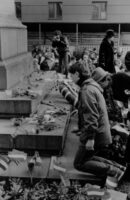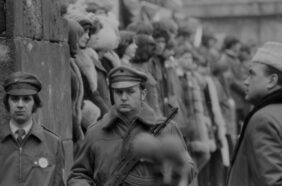PHOTO GALLERY: Why were 15 March celebrations oppressed in communist Hungary?

The commemoration of the Hungarian Civic Revolution and War of Independence of 1848/1849 has always been present throughout our country’s history in one way or another. However, when the communist dictatorship took over in 1945 following Hungary’s Soviet occupation, the once nationwide 15 March celebrations became strictly frowned upon by the regime and those who still dared to organise secret gatherings to remember our 1848 heroes faced serious consequences if caught by the authorities.
Anti-regime ideologies
Although in 1948 the centenary of the Hungarian War of Independence was still commemorated with centrally organised national mass events, its message had already been altered to reflect the official ideology of the era. Overshadowing the heroic acts of the revolution’s main leaders, Kossuth, Petőfi and Táncsics, the General Secretary of the Hungarian Communist Party Mátyás Rákosi was placed as a central figure of the 15 March celebrations, as “the man who fulfilled the objectives of the revolution”.
However, in the following years, the commemorations began to be forcibly balked and eventually scrapped from the list of national holidays by the authorities in 1951 as an official order. Most of the objectives of 1848, from freedom of the press to the repatriation of foreign soldiers to national independence and the release of political prisoners, were unpalatable to a political power that enjoyed the support of the Soviet occupation.
Read also: What do Hungarians celebrate on March 15?
Scrapped national holiday
On paper, no official law forbade citizens to commemorate the revolution in their own way, beyond the official ceremonies, however, in practice the authorities sought to prevent and, in more than one case, to punish everyone who still attended those controversial events.
The crushed 1956 revolution just added fuel to the fire since it also began with the slogans of 15 March, the singing of Kossuth songs, the commemoration at the Bem Statue and the flying of national flags. On top of that, the MUK movement which was determined to resurrect the revolution the following March also kept the authorities on their toes.
From that year, the Kádár regime was painfully aware of the double meaning of 15 March and was paranoid about the possibility of another revolt. The ‘60s saw an unexpected change though when the dictatorship decided to switch strategy and re-enacted the March 15 school celebrations in order to keep the youth under surveillance, preventing them from flocking to the streets to protest. According to tortenelemportal.hu, teachers actively discouraged students to take part in any public events commemorating 15 March. Those who still attempted to demonstrate their patriotism feared serious consequences.
To die for freedom?
In the early years of the regime, the authorities were only called to deal with minor “disturbances”, the number of participants never exceeded a hundred, and scholars are not aware of any major police reprisals. Although it doesn’t correspond in time to the 15 March celebrations, it’s important to mention the case of Sándor Bauer, due to the related location and symbols used in the tragic act. On 20 January 1969, the 17-year-old student doused himself with petrol in the garden of the National Museum while waving national flags in both hands like a living torch in protest against the Soviet occupation and the oppression of the party state.
The previously silenced and oppressed citizens began to regain their voices in the ‘70s. Hundreds of young people gathered at Petőfi Statue in Budapest as part of an illegal demonstration on 15 March 1972, which was violently crushed by the state police. More than 90 participants were dragged away by the authorities and 15 of them were even placed into custody, on the ground of public altercation. In the following years, the regime decreed a virtual martial law for the dreaded date, and several units of the Workers’ Militia and the People’s Army stood up jointly against the protestors on the streets of Budapest.
Blood-stained 15 March demonstrations
The next bloody clash between the protestors and the police took place at the capital’s illustrious Chain Bridge in 1986, but this time the leadership anticipated the crowd and came up with a malicious plan. The people were herded by the police and undercover provocateurs to the Chain Bridge, which was blocked on both ends, and then started beating and hitting the demonstrators. The aim of the police was not just to disperse the crowd – they wanted to set an example with the brutal violence and mass shootings that have gone down in history as the “Battle of Chain Bridge”. This large-scale police terror was also featured in the Western press, with the names of many of the abducted young victims being read out on Radio Free Europe.
The confused leadership was, therefore, compelled to take a step back and tone down the violence. On 15 March 1989, the police demonstrated unusual tolerance towards the demonstrators whose numbers exceeded multiple hundreds at that time. The Communist rule came to an end in the same year, and Hungarians were finally able to freely remember the heroes of the 1848 revolution and held celebrations all across the country.
Read also: Exciting free events in Hungary on 15 March, National Day
Source: tortenelemportal.hu, hvg.hu, ujkor.hu
















